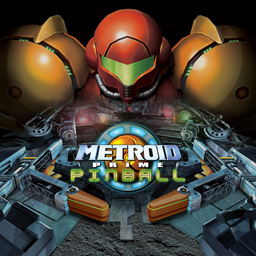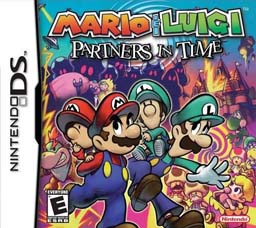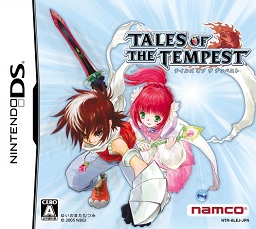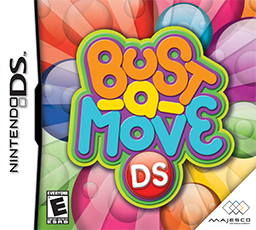
Final Fantasy IV, known as Final Fantasy II for its initial North American release, is a role-playing video game developed and published by Square for the Super Nintendo Entertainment System. Released in 1991, it is the fourth main installment of the Final Fantasy series. The game's story follows Cecil, a dark knight, as he tries to prevent the sorcerer Golbez from seizing powerful crystals and destroying the world. He is joined on this quest by a frequently changing group of allies. Final Fantasy IV introduced innovations that became staples of the Final Fantasy series and role-playing games in general. Its "Active Time Battle" system was used in five subsequent Final Fantasy games, and unlike prior games in the series, IV gave each character their own unchangeable character class.

Mario & Luigi: Superstar Saga is a role-playing video game developed by AlphaDream and published by Nintendo for the Game Boy Advance in 2003. It was re-released for the Wii U's Virtual Console in 2014, Nintendo Switch Online Service in 2023, and remade for the Nintendo 3DS as Mario & Luigi: Superstar Saga + Bowser's Minions in 2017. In the game, Mario and Luigi travel to the Beanbean Kingdom in order to combat Cackletta and Fawful, who stole Princess Peach's voice for the purpose of harnessing the power of a special artifact called the Beanstar.

Castlevania: Dawn of Sorrow is a 2005 action-adventure game developed and published by Konami. It is part of Konami's Castlevania video game series and the first Castlevania game released on the Nintendo DS. The game is the sequel to Castlevania: Aria of Sorrow and incorporates many elements from its predecessor. Dawn of Sorrow was commercially successful. It sold more than 15,000 units in its first week in Japan and 164,000 units in the United States during the three months after its initial release.

Fire Emblem Gaiden is a tactical role-playing game developed by Intelligent Systems and published by Nintendo for the Famicom. Released in March 1992, it is the second installment in the Fire Emblem series and the last to be developed for the Famicom. It builds upon the basic turn-based strategy gameplay of the previous title, while including new elements such as a navigable overworld. Set in the same world as its predecessor, Fire Emblem: Shadow Dragon and the Blade of Light, Gaiden follows the battles of two opposing armies on the continent of Valentia, which is torn apart by political strife involving the princess Celica and her childhood friend Alm.

Metroid Prime Pinball is a pinball video game themed after the Metroid series. The game uses the graphical style and various story elements from Metroid Prime. It was developed by Fuse Games and published by Nintendo for the Nintendo DS in North America and Australia in 2005, in Japan in 2006, and in Europe in 2007. Metroid Prime Pinball uses the basic mechanics of pinball, along with typical pinball items. New mechanics are introduced, such as wall jumping and the ability to fire weapons. The Nintendo DS's touchscreen can be nudged with a finger to alter the pinball's trajectory while in motion.

Mario & Luigi: Partners in Time is a role-playing video game developed by AlphaDream and published by Nintendo for the Nintendo DS handheld game console in late 2005. It is the second game in the Mario & Luigi series, and is the prequel/sequel to the 2003 Game Boy Advance game Mario & Luigi: Superstar Saga. The game was later re-released for the Wii U as a Virtual Console title in 2015, available for purchase from the Nintendo eShop.

Viewtiful Joe: Double Trouble!, known in Japan as Viewtiful Joe: Scratch!, is a video game developed by Clover Studio and published by Capcom for the Nintendo DS. It was released in 2005 in Japan and North America. Capcom partnered with Nintendo to distribute the game in Europe and Australia in early 2006. Viewtiful Joe: Double Trouble! is the fourth game released in the Viewtiful Joe series. The game's story opens on the set of director Captain Blue's new action movie in an amusement park called Movieland. When a mysterious group of villains known as Madow steal the only copy of the film, the superhero Viewtiful Joe and his younger sister Jasmine quickly give chase.

Bujingai (武刃街), known in North America as Bujingai: The Forsaken City and in Europe as Bujingai: Swordmaster, is an action video game developed by Taito in collaboration with Red Entertainment, for the PlayStation 2 console. The game was published by Taito in Japan on December 25, 2003. It was released in North America by BAM! Entertainment and in Europe by 505 Games on July 22, 2004 and February 18, 2005 respectively.

Tales of the Tempest is an action role-playing game developed by Dimps and Namco Tales Studio, and published by Bandai Namco Games for the Nintendo DS exclusive in Japan. A mainline title of the Tales series, previously considered a spin-off "Escort" title, it was released on October 26, 2006. The game makes use of the Tales series' recurring Linear Motion Battle System, customized so characters and actions can be controlled and determined using the DS touch screen, as well as incorporating multiplayer elements. The opening of the game was made by Production I.G and uses the music VS composed by Koda Misono.

ASH: Archaic Sealed Heat is a 2007 tactical role-playing game developed by Mistwalker and Racjin and published by Nintendo for the Nintendo DS exclusively in Japan. The storyline follows Aisya, princess of Millinear, after her kingdom is burned to ashes by a fire monster on her coronation day. Given the ability to revive the dead as ash-formed bodies, she sets out to investigate the causes behind the disaster. The gameplay combines tactical grid-based movement of 2D characters in a field environment, and traditional turn-based battles when two party units engage represented by CGI models.

Bleach: The Blade of Fate is a 2D fighting game that features the cast of characters from the Bleach anime and manga. The game featured Nintendo's Wi-Fi Connection, which allowed players to connect and play against players all over the world. The game modes include story mode, arcade mode, VS mode, training mode, challenge mode, and survival mode, time attack mode and Urahara shop. The game's theme song is "Ichirin no Hana" by High and Mighty Color.

LostMagic is a real-time strategy role-playing video game developed by Taito for the Nintendo DS system. It supports the Nintendo Wi-Fi Connection.

Bomberman Land Touch! is a puzzle video game developed by Hudson Soft for the Nintendo DS. The game was first released in Japan and North America in 2006. Part of the Bomberman franchise, Touch! is the third game in the Bomberman Land series and its first to be released outside Japan.

Heroes of Mana is a 2007 real-time strategy game for the Nintendo DS. It was developed by Brownie Brown and Square Enix and published by Square Enix. It is the ninth game of the Mana series and the fourth entry in the World of Mana subseries, following the release of Dawn of Mana three months prior. Set in a high fantasy universe, Heroes of Mana follows a young soldier, Roget, as he journeys to defend several nations from the ruthless aggression of his own country in a series of battles.

Bust-a-Move DS, known as Hippatte!! Puzzle Bobble in Japan, is a puzzle video game developed by Happy Happening and published by Majesco Entertainment for the Nintendo DS handheld video game console.

Knights in the Nightmare is a strategy-shooter role-playing game hybrid from Sting Entertainment, and the fourth episode in the Dept. Heaven series of video games. It was released by Atlus USA in North America. Sting released a special edition version of Knights in the Nightmare, called the Knights in the Nightmare DHE Series Special Pack; it includes a copy of Yggdra Union: We'll Never Fight Alone for the Game Boy Advance.

Nostalgia is a role-playing video game developed by Red Entertainment and Matrix Software for the Nintendo DS handheld system. Initially released in November 2008 for Japanese audiences by Tecmo, an English version of the game was released for North America by Ignition Entertainment in October 2009. The game's development was headed by producer Keisuke Kikuchi, with programming and three-dimensional graphics by Matrix Software, who had previously developed Square Enix's Nintendo DS versions of Final Fantasy III and IV.

Suikoden Tierkreis (Gensō Suikoden Tierkreis is a role-playing video game for the Nintendo DS developed and published by Konami as part of the Suikoden series. It was released in December 2008 in Japan, and released in English in Europe and North America in March 2009. The game's development was led by project head Osamu Komuta, who had previously been a planner for Suikoden Tactics, with a music staff composed of Norikaku Miura, Yoshino Aoki, Masaharu Iwata, and Kaori Komuro. The game features the opening and ending theme songs "Tears in the Sky" and "Tierkreis" respectively, each performed by Japanese pop idol Satomi Takasugi.

Spore Hero Arena is a science fiction action-adventure game for the Nintendo DS and is a spin-off of Spore Hero which was released in North America on October 6, 2009, and worldwide on October 8. This game is the second Spore game for the Nintendo DS, and focuses more on battling than its predecessor, Spore Creatures. Creatures are now rendered in full 3D and the creature design system has been overhauled. The online functions/multiplayer were closed on 30 June 2014.

Ni no Kuni: Dominion of the Dark Djinn is a role-playing video game developed and published by Level-5. It was released in Japan for the Nintendo DS on December 9, 2010. Players control Oliver, a young boy who sets out on a journey to save his mother. The game is played from a third-person perspective and its world is navigated on foot or by boat. While players navigate Oliver throughout the game's world, other characters can be controlled during battles against enemies; during these battles, players use magic abilities and creatures known as "imajinn", which can be captured and tamed.





















